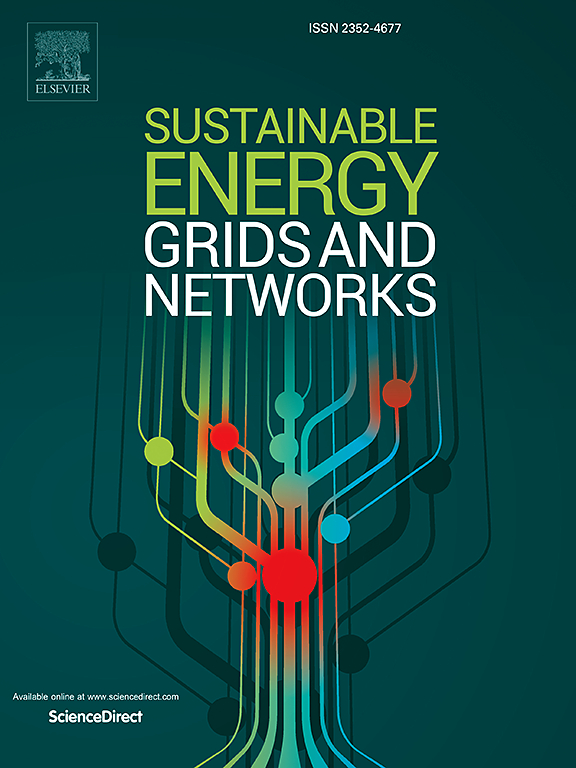A hybrid stochastic-robust optimal strategy of integrated electricity and gas grids in the presence of multi-energy hubs and responsible loads
IF 5.6
2区 工程技术
Q2 ENERGY & FUELS
引用次数: 0
Abstract
The optimal performance of multi-carrier energy systems is becoming increasingly important with the rise of highly efficient and cost-effective utilities in gas and electricity distribution networks. However, the collaborative management of interconnected electricity and gas networks, particularly in the context of renewable energy resources and flexible demand, poses a significant challenge for system operators. To address this, a stochastic-robust optimization approach is recommended to concurrently model the operating costs for both networks integrated with the multi-energy hub system (MEH), incorporating various energy conversion technologies, renewable energy resources (RERs), and gas storage (GS) units to meet heat, cooling, and gas demands. The consequences of power pricing uncertainty are modelled to deal with market power prices using a robust optimization strategy. Other significant uncertainties, such as solar (PV), wind power, electrical demands, gas loads, cooling loads, heating loads, and gas prices, all are handled by stochastic optimization. Additionally, the impact of installed gas and electricity loads during peak hours is examined through adjustable flexible demand response (FDR). The proposed model is formulated as a mixed-integer linear programming (MILP) model and is solved using a CPLEX solver with the GAMS optimization software. The results demonstrate that interconnected MEHs can significantly impact operating costs for both the Gas Distribution Network (GDN) and Electric Distribution Network (EDN) when considering flexible demands and energy sources. Specifically, compared to the risk-neutral case, the total operating cost increased by 2.74 %, rising from $30311.739 to $31141.653 under the worst conditions. In contrast, in the case of risk-averse optimal scheduling of the proposed problem, in the presence of FDR and GS units, the total operating cost decreased to $27283.08, representing a reduction of 12.39 %. This indicates that integrating MEHs and GS units, along with responsive demands, can effectively improve the flexibility of EDN and GDN while significantly reducing overall operating costs.
多能枢纽和责任负荷下的混合随机-鲁棒综合电网优化策略
随着燃气和电力分配网络中高效、经济的公用事业的兴起,多载波能源系统的最佳性能变得越来越重要。然而,互联电力和天然气网络的协同管理,特别是在可再生能源资源和灵活需求的背景下,对系统运营商提出了重大挑战。为了解决这个问题,建议采用一种随机鲁棒优化方法,同时对与多能枢纽系统(MEH)集成的两个网络的运行成本进行建模,该系统结合了各种能量转换技术、可再生能源(rs)和储气(GS)单元,以满足热、冷和气需求。采用鲁棒优化策略对电价不确定性的后果进行建模,以处理市场电价。其他重要的不确定性,如太阳能(PV)、风能、电力需求、天然气负荷、冷负荷、热负荷和天然气价格,都是由随机优化处理的。此外,通过可调节的灵活需求响应(FDR)来检查高峰时段安装的天然气和电力负荷的影响。该模型是一个混合整数线性规划(MILP)模型,并使用CPLEX求解器和GAMS优化软件进行求解。结果表明,在考虑灵活需求和能源的情况下,互联meh会显著影响燃气配电网(GDN)和配电网络(EDN)的运营成本。具体而言,与风险中性情况相比,总运营成本增加了2.74 %,从最坏情况下的30311.739美元上升到31141.653美元。相比之下,在提出的问题的风险规避最优调度情况下,在存在FDR和GS机组的情况下,总运营成本下降到27283.08美元,减少了12.39% %。这表明,整合meh和GS单元,以及响应需求,可以有效提高EDN和GDN的灵活性,同时显著降低总体运营成本。
本文章由计算机程序翻译,如有差异,请以英文原文为准。
求助全文
约1分钟内获得全文
求助全文
来源期刊

Sustainable Energy Grids & Networks
Energy-Energy Engineering and Power Technology
CiteScore
7.90
自引率
13.00%
发文量
206
审稿时长
49 days
期刊介绍:
Sustainable Energy, Grids and Networks (SEGAN)is an international peer-reviewed publication for theoretical and applied research dealing with energy, information grids and power networks, including smart grids from super to micro grid scales. SEGAN welcomes papers describing fundamental advances in mathematical, statistical or computational methods with application to power and energy systems, as well as papers on applications, computation and modeling in the areas of electrical and energy systems with coupled information and communication technologies.
 求助内容:
求助内容: 应助结果提醒方式:
应助结果提醒方式:


